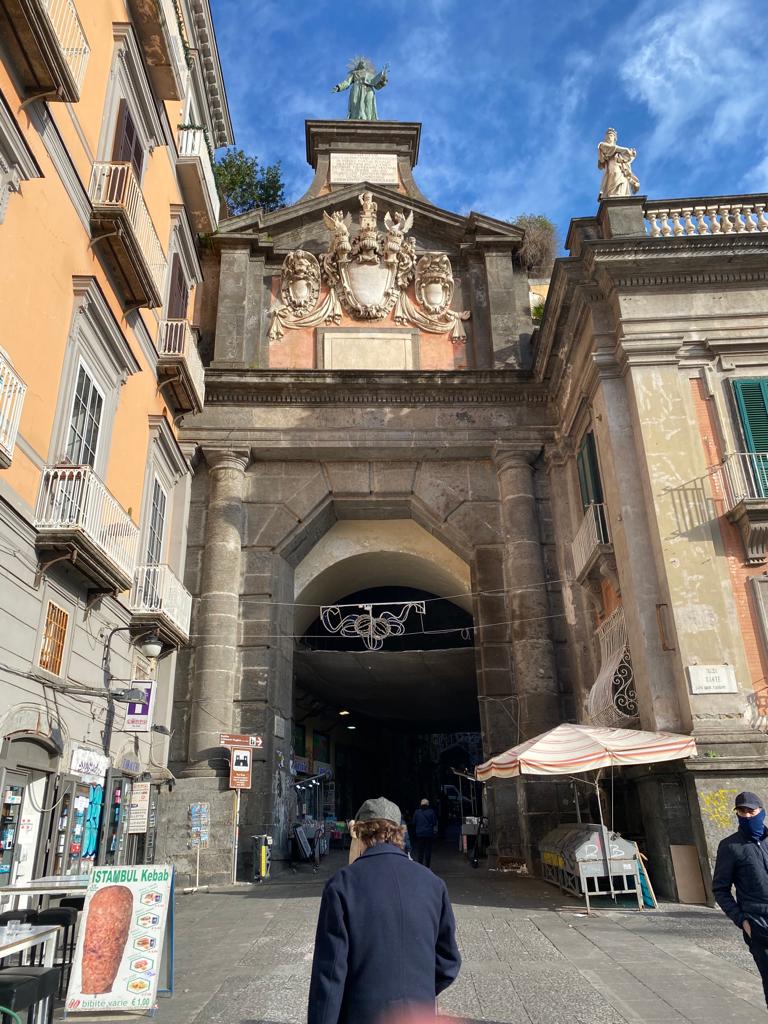It was historically known and frequented for the market that took place every Wednesday for two centuries. A function underlined, to the north, by the presence of a structure with grain pits and, to the south, by the oil deposits.
For this reason the square was officially called “Largo del Mercatello” (Area of the Market) in 1757, when it was identified by the administration of Naples of that time as the ideal spot to create a work that celebrated the greatness of Charles of Bourbon, who brought so much progress to the capital of the kingdom to make it now one of the largest and most advanced cities in Europe.

The most famous architect of the time was chosen for this project, who also was the favorite of the king: Luigi Vanvitelli. Creator of the new royal palace in Caserta and many other important works conceived for that space, on the side of the Aragonese walls, an imposing exedra hemicycle, which should have framed a large equestrian statue of the sovereign to be placed in the center of the square. Embellishments of marble and piperno were planned for the scenographic building and on the highest level, the attic, twenty-six marble statues would be placed to represent the Charles’ s virtues. Four of those statues were commissioned to Giuseppe Sanmartino, the author of the famous Veiled Christ. Furthermore, on the west side, the already existing Port'Alba had to be inserted in the new factory, built in 1625 by the viceroy Don Antonio Alvarez de Toledo to connect the square to the decumanus.
As for the statue of the sovereign that started the Bourbon dynasty, at the beginning only the plaster cast of the famous statue was placed in the center of the square, which was demolished with the Neapolitan Republic of 1799 to be replaced with a statue of Napoleon, eliminated after the return to power of the Bourbons. Meanwhile, on the top of Vanvitelli’s monument a small tower with a large clockwork was installed, characterizing still today, what once was called Foro Carolino.
It was destiny that the subject of the statue chosen to camp in the center of the square should follow the dynastic vicissitudes of the capital of the kingdom. The new statue placed after the return of the Bourbons was destroyed by a violent storm in 1801. Fifty years later, in 1855, the Neapolitans revived the idea of the statue of Charles III and taxed themselves to have it built. A commission for the monument was created and was even paid Irdi, the sculptor, but the project failed. And with the advent of the unitary state in 1861, on the proposal of Luigi Settembrini, it was decided to greet the novelty by canceling the Bourbon identity and focusing instead on a symbol of Italianity with the title of the square to Dante, depicted in the new statue signed by the sculptor Tito Angelini and placed in the center of that wide area.
In order to give a savoyard connotation to the former Foro Carolino, in the previous year the Vanvitellian monument was already been transformed, where, instead of the statue of Charles III, had been opened the main door to the Convitto Nazionale dedicated to Vittorio Emanuele II and housed in the premises of the ancient convent of S.Sebastiano. Of the latter, the two splendid cloisters remain: one representing a very rare Neapolitan example of Roman-Gothic architecture and the other is in Renaissance style.
Copyright video, foto e testi ©️ 2020




Comments powered by CComment